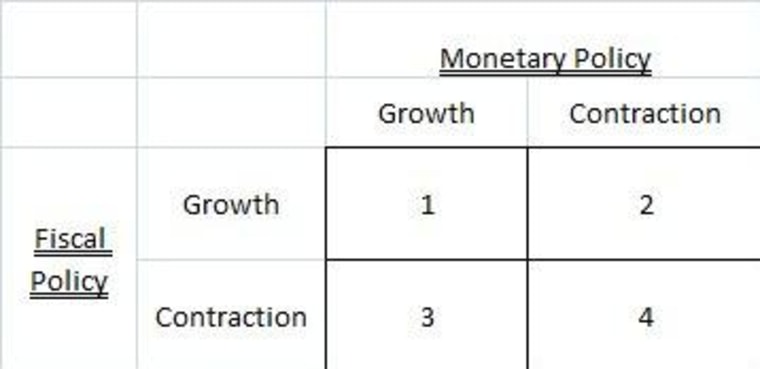The Federal Reserve announced a few new actions today designed to boost growth and jobs. Which begs the question: How much will these new measures help? More precisely, how much can the Fed boost growth on their own, when fiscal policy is pushing in the other direction?
We’ll get to that, but first, here are the two things that Ben and his merry mix of monetarists announced today:
• Forward guidance: They’ll keep interest rates around zero until at least mid-2015, six months longer than in previous statements.
• More bond purchases: They’d spend billions more buying bundled mortgage debt—MBS, or mortgage-backed securities—to help add liquidity and lower longer-term interest rates on the financial side of the housing market.
In a research note, economist Jan Hatzius at Goldman Sachs predicted the other day that such a program might boost GDP growth by ¼-½ point over the next year. He added:
[E]ven if the FOMC errs on the side of a more aggressive move, we expect GDP to grow little more than 2% next year, similar to this year’s pace.
In reality, the Fed did offer a strong statement implying that they wouldn’t go aviary (i.e., turn into inflation hawks) the minute growth accelerated.
To support continued progress toward maximum employment and price stability, the Committee expects that a highly accommodative stance of monetary policy will remain appropriate for a considerable time after the economic recovery strengthens.
Still, note Hatzius’s estimate of 2% GDP growth next year. In other words, even if the Fed did pretty much go all in, we’d still be looking at a growth rate that was about where we are. Which keeps the unemployment rate about where it is.
Why isn’t this stuff more effective than that? Because it’s monetary policy targeting interest rates and it needs to be complemented by fiscal policy boosting demand.
I've written about this a lot, and find it useful to think about this little box you see below, with monetary stimulus (like today’s Fed moves) on the x-axis and fiscal stimulus, like the American Jobs Act (AJA), which President Obama propsed but has not been taken up by Congress, on the y-axis.
We need to be in box 1. Ben B has also called for Congress to put us in box 1. The President, by proposing the AJA a year ago, tried to steer us toward box 1. But alas, we are in box 3.
That’s better than 4, but the fact is that stimulative fiscal and monetary policies are complements, not substitutes. Simply put, we need more consumer and investor demand to give the Fed’s low interest rates the traction they’ve lacked. They’ve set the table nicely, but the diners aren’t taking advantage of the discounted meal.
To tell you the truth, given the fact that interest rates are already really low (including mortgage rates) and big firms are sitting on large cash reserves, if I had to choose between 3 and 2 right now, I’d choose 2—or at least a neutral Fed with aggressive fiscal stimulus in the form of jobs measures. I still think that weak demand is a bigger weight on growth right now than the cost of credit, short or long-term. (Though I don’t want to overdo this point—credit availability is still constrained, especially for home loans applied for by people without stellar credit histories).
At any rate, good for the Fed. Bernanke has consistently stressed the damage done to people’s lives by the lack of job growth, calling high unemployment a “grave concern” and trying to explain to a lot of market types—some of whom are on the Fed’s board—how the benefits of these Fed actions outweigh potential costs in terms of future inflation or financial market distortions.
And I think these moves will help a little bit. That’s the good part and the bad part: We need more than a little bit of help.
Jared Bernstein served from 2009 to 2011 as chief economist to Vice President Joe Biden, and as a member of President Obama's economic team. He is currently a Senior Fellow at the Center on Budget and Policy Priorities, and an msnbc contributor.

